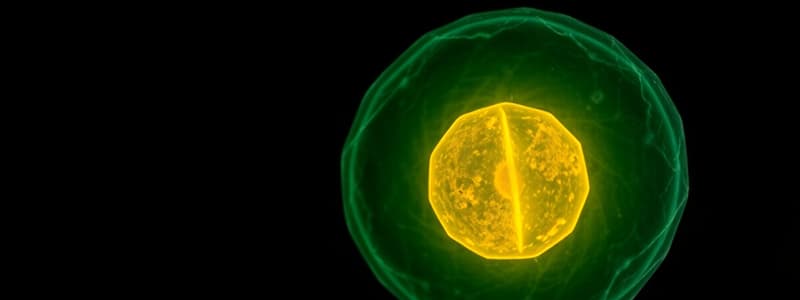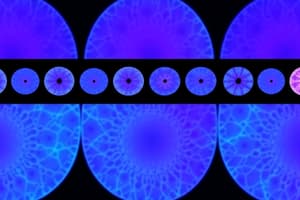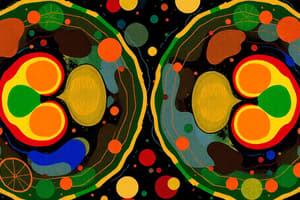Podcast
Questions and Answers
Which process is responsible for producing sperm and egg cells?
Which process is responsible for producing sperm and egg cells?
- Mitosis
- Cytokinesis
- Interphase
- Meiosis (correct)
Mitosis results in the production of haploid cells.
Mitosis results in the production of haploid cells.
False (B)
What is the primary purpose of cytokinesis?
What is the primary purpose of cytokinesis?
To divide the cytoplasm and organelles into two daughter cells
During __________, chromosomes replicate and prepare for cell division.
During __________, chromosomes replicate and prepare for cell division.
Match the following stages with their correct descriptions:
Match the following stages with their correct descriptions:
What is the result of somatic cell division?
What is the result of somatic cell division?
Cells in the body are produced through meiosis.
Cells in the body are produced through meiosis.
What are diploid cells?
What are diploid cells?
What is the role of centrioles during cell division?
What is the role of centrioles during cell division?
Cytokinesis and telophase occur simultaneously in the cell cycle.
Cytokinesis and telophase occur simultaneously in the cell cycle.
What do you call the process when haploid gametes fuse to form a zygote?
What do you call the process when haploid gametes fuse to form a zygote?
Somatic cells are referred to as __________ cells due to their two sets of chromosomes.
Somatic cells are referred to as __________ cells due to their two sets of chromosomes.
What is the main purpose of meiosis in gamete production?
What is the main purpose of meiosis in gamete production?
Match the following terms with their definitions:
Match the following terms with their definitions:
Meiosis results in daughter cells that are diploid.
Meiosis results in daughter cells that are diploid.
What structure forms during cytokinesis that helps separate the cytoplasm?
What structure forms during cytokinesis that helps separate the cytoplasm?
What is the main purpose of meiosis?
What is the main purpose of meiosis?
Meiosis consists of only one nuclear division.
Meiosis consists of only one nuclear division.
Name the four phases of meiosis I.
Name the four phases of meiosis I.
During meiosis, the cells produced contain a __________ number of chromosomes.
During meiosis, the cells produced contain a __________ number of chromosomes.
What occurs during the synapsis phase of Prophase I?
What occurs during the synapsis phase of Prophase I?
Match the meiosis phases with their descriptions:
Match the meiosis phases with their descriptions:
DNA is replicated during the interphase between meiosis I and meiosis II.
DNA is replicated during the interphase between meiosis I and meiosis II.
The two primary divisions of meiosis are called __________ division and __________ division.
The two primary divisions of meiosis are called __________ division and __________ division.
Flashcards
Somatic Cell Division
Somatic Cell Division
Cell division that produces two identical daughter cells, each with the same number of chromosomes as the parent cell.
Reproductive Cell Division
Reproductive Cell Division
Cell division that produces four daughter cells, each with half the number of chromosomes as the parent cell.
Interphase
Interphase
The phase between cell divisions where the cell grows, replicates its DNA, and prepares for division.
DNA Replication
DNA Replication
Signup and view all the flashcards
Prophase (Mitosis)
Prophase (Mitosis)
Signup and view all the flashcards
Metaphase (Mitosis)
Metaphase (Mitosis)
Signup and view all the flashcards
Anaphase (Mitosis)
Anaphase (Mitosis)
Signup and view all the flashcards
Telophase (Mitosis)
Telophase (Mitosis)
Signup and view all the flashcards
Cytokinesis
Cytokinesis
Signup and view all the flashcards
Meiosis I
Meiosis I
Signup and view all the flashcards
Synapsis
Synapsis
Signup and view all the flashcards
Crossing Over
Crossing Over
Signup and view all the flashcards
Metaphase I
Metaphase I
Signup and view all the flashcards
Anaphase I
Anaphase I
Signup and view all the flashcards
Telophase I
Telophase I
Signup and view all the flashcards
Meiosis II
Meiosis II
Signup and view all the flashcards
Prophase II
Prophase II
Signup and view all the flashcards
Metaphase II
Metaphase II
Signup and view all the flashcards
Anaphase II
Anaphase II
Signup and view all the flashcards
Telophase II
Telophase II
Signup and view all the flashcards
Gametes
Gametes
Signup and view all the flashcards
Zygote
Zygote
Signup and view all the flashcards
Somatic Cells
Somatic Cells
Signup and view all the flashcards
Homologous Chromosomes
Homologous Chromosomes
Signup and view all the flashcards
Diploid Cells
Diploid Cells
Signup and view all the flashcards
Haploid Cells
Haploid Cells
Signup and view all the flashcards
Study Notes
Cell Division
- Somatic Cell Division - Single parent cell divides into two daughter cells through mitosis and cytokinesis. The daughter cells have the same number and type of chromosomes as the parent.
- Reproductive Cell Division - Produces sperm and egg cells through meiosis. The process involves nuclear division (meiosis) followed by cytokinesis.
Interphase
- This phase occurs between cell divisions.
- Chromosomes are replicated.
- RNA and proteins for cell growth are produced.
- DNA replicates by partially unfolding, exposing nitrogen bases.
- Complementary nitrogen bases pair with the exposed bases, creating two DNA molecules.
Mitosis
- Occurs after interphase.
- Prophase: Chromosomes condense, nuclear membrane and nucleoli disappear, centrioles replicate, and spindle fibers appear.
- Metaphase: Chromosomes align at the cell's equator.
- Anaphase: Centromeres split, and sister chromatids separate, moving to opposite poles.
- Telophase: Chromosomes uncoil, nuclear membrane reappears, nucleoli reform, spindle fibers disappear, and cytoplasm divides (cytokinesis).
- The result is two daughter cells identical to the parent cell.
Meiosis
- Reduction Division (Meiosis I)
- Occurs in two stages.
- Prophase I: Chromosomes condense, nuclear membrane and nucleoli disappear, centrioles replicate, and spindle fibers appear. Homologous chromosomes pair (synapsis), forming tetrads. Crossing-over occurs, exchanging genetic material between chromatids.
- Metaphase I: Homologous chromosomes line up at the cell's equator.
- Anaphase I: Homologous chromosome pairs separate and move to opposite poles.
- Telophase I: Chromosomes uncoil, nuclear membrane reappears, nucleoli reform, spindle fibers disappear, and cytoplasm divides (cytokinesis).
- Equatorial Division (Meiosis II)
- Prophase II: Chromosomes condense, nuclear membrane and nucleoli disappear, centrioles replicate, and spindle fibers appear.
- Metaphase II: Chromosomes line up at the cell's equator.
- Anaphase II: Sister chromatids separate and move to opposite poles.
- Telophase II: Chromosomes uncoil, nuclear membrane reappears, nucleoli reform, spindle fibers disappear, and cytoplasm divides (cytokinesis).
Key Terms
- Gametes: Sex cells (sperm and egg).
- Zygote: A fertilized egg cell.
- Somatic cells: Body cells (not gametes).
- Homologous chromosomes: Matching pairs of chromosomes.
- Diploid cells: Cells containing two sets of chromosomes (2n).
- Haploid cells: Cells containing one set of chromosomes (n).
Meiosis Facts
- Meiosis results in four haploid daughter cells.
- Crossing-over in Prophase I contributes to genetic diversity.
- Meiosis ensures that offspring inherit half their chromosomes from each parent.
Studying That Suits You
Use AI to generate personalized quizzes and flashcards to suit your learning preferences.




